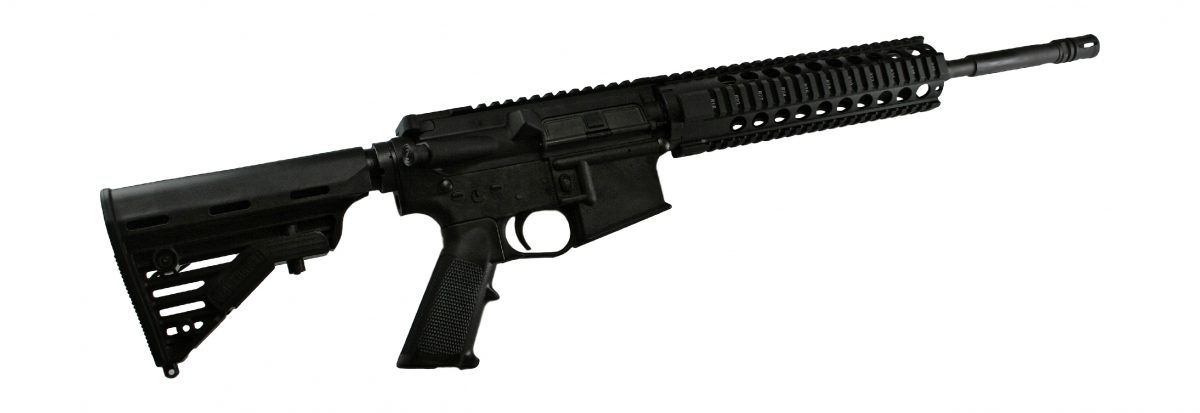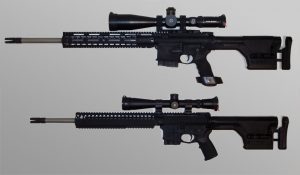 Planning your AR Build
Planning your AR Build
AR-15 or AR-10?
The first question you have to ask is: Do I want an AR-15 or AR-10? What it comes down to, is what do you want? The biggest difference is the AR-15 was developed based on the 5.56mm NATO round, and the AR-10 was made for the .308 (7.62mm NATO). So, with the larger round, you get more power, but also more weight and less capacity. Check these links out for more discussion on the topic:
http://thefiringline.com/forums/showthread.php?t=262223
https://forums.1911forum.com/showthread.php?t=458523
https://www.ar15.com/archive/topic.html?b=3&f=118&t=485785
Keep in mind, these are forums, and are full of opinions that may not necessarily be ours.
What is the purpose of my AR?
This question will help guide you to what parts to get and where to go to get them. Do you want a light weight post apocalypse high round rifle? Do you want a full sized tack driver? Are you just looking for the traditional reliability of the military platform? Once you know this, you can begin to sift through all of the opinions. And there are a lot of opinions.
What caliber do I want?
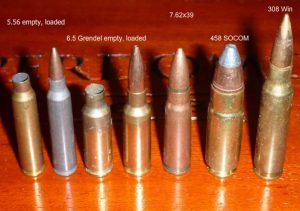 The AR-15 has TONS of caliber options, everything from .17 up to .458 SOCOM. The ‘gold standard’, the basic round, is the 5.56x45mm NATO round. Some of the most popular variations include the 7.62x39mm (AK round), the 300AAC/Blackout round, .22lr, and the 9x19mm pistol round.
The AR-15 has TONS of caliber options, everything from .17 up to .458 SOCOM. The ‘gold standard’, the basic round, is the 5.56x45mm NATO round. Some of the most popular variations include the 7.62x39mm (AK round), the 300AAC/Blackout round, .22lr, and the 9x19mm pistol round.
https://www.gunsamerica.com/blog/build-an-ar-15-ar-calibers/ – this site provides a good overview of some of the caliber options.
Of note in the discussion on caliber, the difference between 5.56 NATO, .223 Remington, and .223 Wylde is something to consider. The key differences are slight variations in the dimensions of the chambers. Functionally speaking, this is what you need to keep in mind: the 5.56 NATO round will NOT safely run in the .223 Remington chamber, but the .223 Remington round will work in the 5.56 NATO chamber. The .223 Wylde chamber will run both rounds with no issues.
http://ar15armory.com/forums/topic/12534-223556-nato-vs-223-wylde/ – this discussion does a good job summing it all up.
Selecting the Lower
100% or 80%? Aluminum or Poly? Billet or forged? What is the difference? Why should I care? All of this is important when planning what you want
100% or 80%? AR lowers come fully completed or only 80% complete. An 80% complete lower is manufactured up to the last possible point before it is considered a firearm. Ignoring all of the legal or politica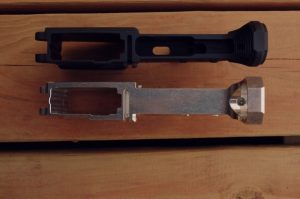 l questions, first, you should consider if you want to do the extra work to complete an 80%. Are you into Do-It-Yourself kind of person? If you go to the hardware store for a bird house, do you buy a prebuilt and just paint and hang it, or do you like to have the satisfaction of completing every step? Of you are that kind of handyperson, then the 80% is right up your alley. If you are intimidated by power tools, and prefer more of an assemble-by-numbers project, then the finished lower is more your style. You can even find ones that have the parts kit installed, or you can get the parts kit installed by a qualified gunsmith.
l questions, first, you should consider if you want to do the extra work to complete an 80%. Are you into Do-It-Yourself kind of person? If you go to the hardware store for a bird house, do you buy a prebuilt and just paint and hang it, or do you like to have the satisfaction of completing every step? Of you are that kind of handyperson, then the 80% is right up your alley. If you are intimidated by power tools, and prefer more of an assemble-by-numbers project, then the finished lower is more your style. You can even find ones that have the parts kit installed, or you can get the parts kit installed by a qualified gunsmith.
Aluminum or Polymer? The next question is, do you want aluminum or polymer? The aluminum lower is going to be more durable when it comes to drops, or scratches and dings or corrosives. The polymer lower will generally be lighter, and if you get a quality one, like a Tennessee Arms or Hybrid 80 hybrid lower, you can mitigate most of the durability issues. The polymer 80% lowers are also easier to mill. Just keep in mind when you are reading forums that not all polymers are created equal. We recommend looking for glass reinforced nylon.
Billet vs forged – As a subset of the aluminum lower, CNC milled billet lowers have become more available, in both 80% and 100% versions. Though many forum goers will lay down the argument that billet is stronger, and talk about inclusions in the forging process, the reality is that it is more about looks and preference than any real functional difference. The maximum pressure exerted in the operation of the rifle is the 9-12lbs of pressure from the hammer, and that is if you dry fire it with no upper. If you treat your AR like you treat all of your other weapons, most likely, you will not notice any real difference. So, if you like the looks of billet, then go with that. If you are price conscious, or don’t like the look of billet, then go with forged.
Barrel Options
Barrels come in all different lengths, linings and finishes. One question is stainless or black? This is really just a look preference. Do you like shiny or muted? It’s totally up to you.
What you need to know about barrel length: size does matter. Anything less than 16” on a standard AR-15 may cause complications. With the law.. 14.5” barrels are generally Short barreled rifle territory, (SBR in ATF terms) and require a tax stamp. 10.5” and below are used on AR-15 pistols. Longer barrels are generally used for longer distance and accuracy.
On barrel linings: Barrel linings are one of those things that there are as many opinions as there are bullets in my cabinet. The thing to keep in mind is that opinions are rarely based in fact, and your specific environment and purpose will determine if you need a lined barrel.
Your Bolt Carrier group and You!
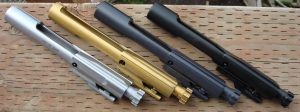
The bolt carrier group runs all of the action in your AR-15. Within BCGs, there are a few different options. First, you have coating options: DLC, NiB, MagPhos and Nitride, being the most popular, Then there is a form choice, Direct Gas impingement or a piston based system.
On the gas vs piston, here is a great article: http://www.gundigest.com/tactical-gear/tactical-guns/ar-15-gas-impingement-vs-piston
As far as coatings, the options range from the military standard magnesium phosphate to the high-end diamond-like carbon coating. On this scale, you go from the highest to lowest coefficient of friction (how much it drags), and the lowest to highest hardness. Magnesium Phosphate is the basic coating, Nitride is a minimal upgrade, being slightly harder than MagPhos. Then, NiB and DLC coatings are your premium coatings. NiB and DLC are both harder and slicker than the standard MagPhos. NiB has a CoF that is about half that of MagPhos and DLC is about 1/4th of that. Whether it is worth the higher price is up to you.
Pistol Grips, Stocks and Handguards, Oh My!
Pistol grips, stocks, and hand guards, also called furniture, will open up your first level of accessorizing. Pistol grips and stocks focus on color and ensuring you have a secure hold on your AR. With hand guards, there are a few things to keep in mind. First, you must decide on how to mount the hand guards. There are two types of mounts, free float and drop in. Free floating hand guards attach directly to the barrel nut and upper receiver. Drop in rails rest on the front of the barrel, on the gas block, and snap into a delta ring assembly. Here is a good guide on the differences:
https://monstrumtactical.com/blogs/guides/78840643-ar-15-quad-rail-buyers-guide-drop-in-or-free-float
It has been my experience that the drop in quad rail is a cheaper solution if you already have a rifle, but can cause a lot of issues with accuracy and will hold less accessories. A free floating rail is heavier and more complicated to install. If you are buying your first rifle, and not upgrading, I would go with free floating.
Another thing to consider is what type of accessories you will be mounting to your hand guard. The current most popular mounting methods are Weaver/Picatinny rails, KeyMod and M-Lok. Weaver/picatinny rails are the standard for most devices. In fact, both KeyMod and M-Lok offer picatinny mounts for the system. The advantage of KeyMod and M-Lok is that they are lighter and less abrasive on your hands. KeyMod is more of a open standard, while M-Lok is the sole domain of MagPul. Here is a good article showing the differences between M-Lok and KeyMod. http://www.luckygunner.com/lounge/keymod-vs-m-lok-ar-rail-standard/
That should be enough to get you started and get you excited about putting together your first AR.

